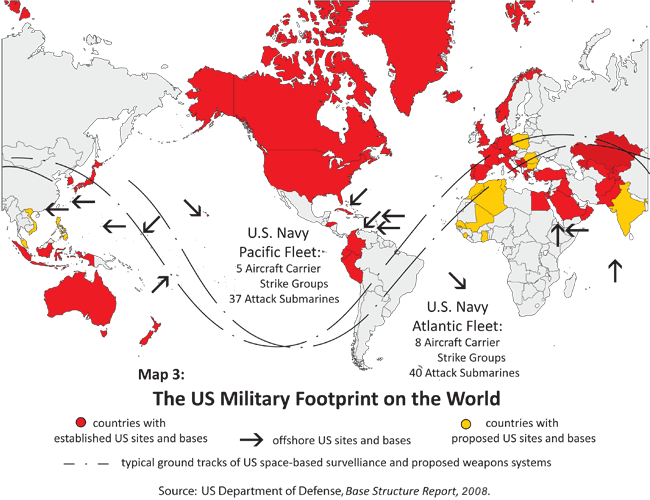by Catherine Lutz
Much about our current world is unparalleled: holes in the ozone layer, the commercial patenting of life forms, degrading poverty on a massive scale, and, more hopefully, the rise of concepts of global citizenship and universal human rights. Less visible but equally unprecedented is the global omnipresence and unparalleled lethality of the U.S. military, and the ambition with which it is being deployed around the world. These bases bristle with an inventory of weapons whose worth is measured in the trillions and whose killing power could wipe out all life on earth several times over. Their presence is meant to signal, and at times demonstrate, that the US is able and willing to attempt to control events in other regions militarily. The start of a new administration in Washington, and the possibility that world economic depression will give rise to new tensions and challenges, provides an important occasion to review the global structures of American power.
Officially, over 190,000 troops and 115,000 civilian employees are massed in 909 military facilities in 46 countries and territories.[1] There, the US military owns or rents 795,000 acres of land, and 26,000 buildings and structures valued at $146 billion. These official numbers are quite misleading as to the scale of US overseas military basing, however, excluding as they do the massive buildup of new bases and troop presence in Iraq and Afghanistan, as well as secret or unacknowledged facilities in Israel, Kuwait, the Philippines and many other places. $2 billion in military construction money has been expended in only three years of the Iraq and Afghanistan wars. Just one facility in Iraq, Balad Air Base, houses 30,000 troops and 10,000 contractors, and extends across 16 square miles with an additional 12 square mile “security perimeter.”

Deployed from those battle zones in Afghanistan and Iraq to the quiet corners of Curacao, Korea, and England, the US military domain consists of sprawling Army bases, small listening posts, missile and artillery testing ranges, and berthed aircraft carriers.[2] While the bases are literally barracks and weapons depots and staging areas for war making and ship repair facilities and golf courses and basketball courts, they are also political claims, spoils of war, arms sales showrooms, toxic industrial sites, laboratories for cultural (mis)communication, and collections of customers for local bars, shops, and prostitution.
The environmental, political, and economic impact of these bases is enormous and, despite Pentagon claims that the bases simply provide security to the regions they are in, most of the world’s people feel anything but reassured by this global reach. Some communities pay the highest price: their farm land taken for bases, their children neurologically damaged by military jet fuel in their water supply, their neighbors imprisoned, tortured and disappeared by the autocratic regimes that survive on US military and political support given as a form of tacit rent for the bases. Global opposition to U.S. basing has been widespread and growing, however, and this essay provides an overview of both the worldwide network of U.S. military bases and the vigorous campaigns to hold the U.S. accountable for that damage and to reorient their countries’ security policies in other, more human, and truly secure directions.
Japan Focus for more
